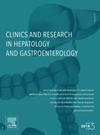炎症性肠病患者肌肉减少症的患病率和影响:一项前瞻性队列研究
IF 2.6
4区 医学
Q2 GASTROENTEROLOGY & HEPATOLOGY
Clinics and research in hepatology and gastroenterology
Pub Date : 2025-02-26
DOI:10.1016/j.clinre.2025.102555
引用次数: 0
摘要
背景:炎症性肠病(IBD)患者伴有肌肉减少症的发病风险增加。本研究的目的是利用形态学和功能标准评估IBD门诊患者肌肉减少症的患病率。方法:在这项前瞻性队列研究中,纳入了2023年3月1日至31日日间住院的所有IBD患者。肌肉质量和功能分别通过生物电阻抗分析和握力测量进行评估。可能的肌肉减少症被定义为握力降低(结果:纳入60例克罗恩病(52%)或溃疡性结肠炎(48%)患者,中位年龄为37岁(四分位数间距[IQR]: 28-54)。其中55%是女性。大多数患者缓解(67%,n=40)。在乳糜泻患者中,受累的是回结肠(48%)、回肠(35%)或结肠(16%)。30%的病例有ibd相关的消化手术史。中位体重指数(BMI)为24 (IQR: 21-27)。肌少症、可能肌少症和肌少症的患病率分别为10%、18%和20%。骨骼肌减少症患者明显年龄较大(59岁vs 36岁,p=0.01),病程较长(20年vs 8年,p=0.003),更容易出现相关的关节炎症(27% vs 6%, p=0.01)和CD (80% vs 49%, p=0.36)。肌萎缩与手术史(67% vs 21%, p=0.004)和较低的BMI (21 vs 24, p=0.001)显著相关。结论:在IBD门诊患者的前瞻性队列中,分别有10%和20%的患者患有肌肉减少症和肌肉减少症。因此,对这一人群进行肌少症筛查似乎是必要的,包括不符合营养不良标准的缓解期稳定门诊患者和超重患者,根据文献,肌少症与较差的临床结果和术后并发症增加有关。需要介入研究来评估多学科治疗肌肉减少症对生活质量和疾病进展的影响。本文章由计算机程序翻译,如有差异,请以英文原文为准。
Prevalence and impact of sarcopenia in patients with inflammatory bowel diseases: A prospective cohort study
Background
Inflammatory bowel disease (IBD) patients with sarcopenia are at increased morbidity risk. The aim of this study was to assess the prevalence of sarcopenia in IBD outpatients using both morphological and functional criteria.
Methods
In this prospective cohort study, all IBD patients admitted to the day hospital unit between March 01 and 31, 2023 were included. Muscle mass and function were evaluated using bioelectrical impedance analysis and handgrip strength measurement, respectively. Probable sarcopenia was defined as reduced handgrip strength (<16–27 kg). Myopenia was defined by a low appendicular muscle mass index (<5.5–7 kg/m²). Sarcopenia was diagnosed based on the coexistence of reduced muscle strength and muscle mass. Disease activity, therapeutic changes, hospitalizations, and IBD-related surgeries were assessed at month 6.
Results
Sixty patients with either Crohn's disease (CD, 52 %) or ulcerative colitis (48 %), with a median age of 37 years (interquartile range [IQR]: 28–54), were included. Fifty-five percent were women. Most patients were in remission (67 %, n = 40). In CD patients, the involvement was ileocolic (48 %), ileal (35 %), or colonic (16 %). A history of IBD-related digestive surgery was noted in 30 % of cases. The median body mass index [BMI] was 24 (IQR: 21–27). The prevalence of sarcopenia, probable sarcopenia, and myopenia was 10 %, 18 %, and 20 %, respectively. Sarcopenic patients were significantly older (59 vs 36 years, p = 0.01), had a longer disease duration (20 vs 8 years, p = 0.003), were more likely to have associated joint inflammation (27 % vs 6 %, p = 0.01) and CD (80 % vs 49 %, p = 0.36). Myopenia was significantly associated with a history of surgery (67 % vs 21 %, p = 0.004) and a lower BMI (21 vs 24, p = 0.001).
Conclusion
In this prospective cohort of IBD outpatients, 10 % and 20 % of patients had sarcopenia and myopenia, respectively. Screening for sarcopenia therefore seems essential in this population, including in stable outpatients in remission who do not meet malnutrition criteria and in overweight patients, as according to the literature, sarcopenia is associated with poorer clinical outcomes and increased postoperative complications. Interventional studies are needed to assess the impact of multidisciplinary treatment of sarcopenia on quality of life and disease progression.
求助全文
通过发布文献求助,成功后即可免费获取论文全文。
去求助
来源期刊

Clinics and research in hepatology and gastroenterology
GASTROENTEROLOGY & HEPATOLOGY-
CiteScore
4.30
自引率
3.70%
发文量
198
审稿时长
42 days
期刊介绍:
Clinics and Research in Hepatology and Gastroenterology publishes high-quality original research papers in the field of hepatology and gastroenterology. The editors put the accent on rapid communication of new research and clinical developments and so called "hot topic" issues. Following a clear Editorial line, besides original articles and case reports, each issue features editorials, commentaries and reviews. The journal encourages research and discussion between all those involved in the specialty on an international level. All articles are peer reviewed by international experts, the articles in press are online and indexed in the international databases (Current Contents, Pubmed, Scopus, Science Direct).
Clinics and Research in Hepatology and Gastroenterology is a subscription journal (with optional open access), which allows you to publish your research without any cost to you (unless you proactively chose the open access option). Your article will be available to all researchers around the globe whose institution has a subscription to the journal.
 求助内容:
求助内容: 应助结果提醒方式:
应助结果提醒方式:


